William Reid Dick
Sir William Reid Dick KCVO RA (13 January 1879–1 October 1961) was a Scottish sculptor known for his innovative stylisation of form in his monument sculptures and simplicity in his portraits. He became an Associate of the Royal Academy in 1921, and a Royal Academician in 1928. Dick served as president of the Royal Society of British Sculptors from 1933 to 1938. He was knighted by King George V in 1935. He was Sculptor in Ordinary for Scotland to King George VI from 1938 until his death.
William Reid Dick | |
|---|---|
| Born | 13 January 1879 Glasgow, Scotland |
| Died | 1 October 1961 (aged 82) Maida Vale, London |
| Nationality | British |
| Alma mater | |
| Known for | Sculpture |
Biography
Early life
Born into a working class family in Glasgow, Dick was apprenticed to a firm of stonemasons at the age of twelve and during the next five years he learned to carve stone and took evening classes at the Glasgow School of Art.[1] In 1892, under the supervision of George Frampton, Dick worked on some of the external carvings for the Kelvingrove Art Gallery and completed his apprenticeship in 1896.[2][1] From 1904 to 1907, Dick returned to the Glasgow School of Art to take a mixture of day and evening classes in drawing and sculpture.[1] In 1907, he graduated and accepted a teaching position at the Bellshill Academy in Lanarkshire but moved to London in 1908.[1] There Dick took evening classes at the South London Technical School of Art whilst working as a studio assistant for the sculptor Edwin Whitney-Smith.[1] Also in 1908, Dick had his first work exhibited at the Royal Academy in London.[3] He earned further recognition in 1911 with a marble bust of Harry Lauder which was also shown at the Royal Academy.[4]
In 1914 Dick married Catherine Emma Treadwell, with whom he had three children. The couple lived in the St John's Wood area of London until 1938 when they purchased a large house and studio in Maida Vale, where they lived for the rest of their lives.[4]
World War I
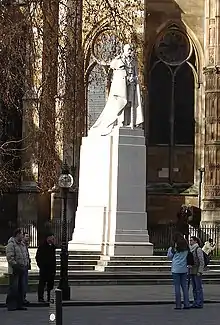
In September 1914 Dick joined the Territorial Army and from 1915 to 1919 served with the Royal Engineers in both France and Palestine.[5] When Dick enlisted in September 1914 he joined the 5th London Field Ambulance section of the Royal Army Medical Corpsand subsequently transferred to the 3rd Army Field Survey Co, part of the Royal Engineers and then the 7th Field Survey Co.[5][3] He was described as a photographer with the 7th Field Survey Co. His Army Service record shows his profession as "sculptor". He was awarded the 1915 Star and the British and Victory Medals.[3] While serving in northern France, Dick produced a number of small statuettes by using the local clay deposits.[6]
Post-war career
Dick designed several war memorials notably at Bushey, at Rickmansworth and the eagle sculpture atop the Royal Air Force Memorial on the Victoria Embankment in London.[3][4] He received a major commission for the Kitchener Memorial Chapel (1922–25) in St Paul's Cathedral, London.[4] The focal point of this design was a Pièta, which won a gold medal at the Paris International Exhibition of Modern Decorative and Industrial Arts in 1925. These works secured his reputation and election to the Royal Academy in 1928.[7] His work was part of the sculpture event in the art competition at the 1928 Summer Olympics.[8] In 1935 Dick was Knighted and elected President of the Royal Society of British Sculptors, a post he held until 1938.[7] From 1938 to 1952 Dick served as King's Sculptor in Ordinary for Scotland and then, from 1952 until his death, Dick was the Queen's Sculptor in Ordinary for Scotland.[7][9] He attended numerous royal events and created several portraits and memorials to members of the Royal Family.[4]
Alongside the public monuments and memorials Dick created he also sculpted busts and statuettes which he exhibited on a regular basis at the Royal Academy, at the Royal Glasgow Institute of the Fine Arts, the Royal Scottish Academy, the Royal Scottish Watercolour Society and at the Paris Salon.[9] Throughout his career, Dick served on numerous committees, among these the Royal Fine Art Commission (1928–42), the Royal Mint Advisory Committee (1936–53), and the Board of Trustees of the Tate Gallery (1934–41).[3]
Dick died at his home in Maida Vale and was cremated at Golders Green crematorium.[4] In October 1963 a memorial tablet to him was unveiled in the crypt of St Pauls' Cathedral.[4] His archives are held by the Tate Gallery.[1][2]
Public works
1920–1929
| Image | Title / subject | Location and coordinates |
Date | Type | Material | Dimensions | Designation | Wikidata | Notes |
|---|---|---|---|---|---|---|---|---|---|
| Angus Watson and Co Ltd war memorial | Ellison Buildings, Newcastle upon Tyne | 1920 | Plaque | Bronze | [10] | ||||
.jpg.webp) More images |
War memorial | Churchyard of St Mary's, Rickmansworth | 1921 | Cenotaph with sculptures of Grief & Victory | Stone | 4.3m tall | Grade II | Q26583838 | [11][12] |
 More images |
War memorial | Council Office Gardens, Rickmansworth | 1921 | Statue on plinth | Bronze and brick | Grade II | Q26631648 | Originally part of the Rickmansworth war memorial, relocated 1978.[13][14] | |
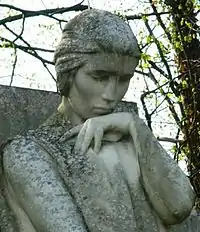 More images |
War memorial | Bushey, Hertfordshire | 1922 | Sculpture | Stone | 4.1m tall | Grade II | Q26397596 | [15][16] |
 More images |
Royal Air Force war memorial | Victoria Embankment, London | 1923 | Sculpture on pillar | Bronze and stone | Grade II* | Q7373614 | Architect, Sir Reginald Blomfield.[6][17][18] | |
 |
Pietà | All Souls' Chapel, St Paul's Cathedral, London | 1925 | Sculpture group | Portland stone | [19][20][21] | |||
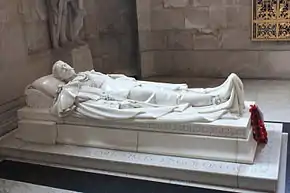 |
Lord Kitchener | All Souls' Chapel, St Paul's Cathedral, London | 1925 | Sculpture | Marble | [19][20] | |||
| St Michael & St George | All Souls' Chapel, St Paul's Cathedral, London | c. 1925 | Two statues | [19][20] | |||||
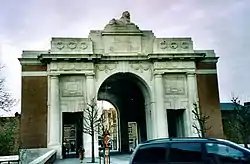 More images |
Menin Gate | Ypres, Belgium | 1927 | Decoration & sculpture | Stone | Q1822397 | Architect, Reginald Blomfield.[22] |
1930–1939
| Image | Title / subject | Location and coordinates |
Date | Type | Material | Dimensions | Designation | Wikidata | Notes |
|---|---|---|---|---|---|---|---|---|---|
 More images |
Leverhulme Memorial | Port Sunlight, Merseyside | 1930 | Obelisk with sculpture group | Granite and bronze | Grade II | Q15979036 | Architect, James Lomax-Simpson.[23][24] | |
 |
Controlled Energy | Unilever House, London | 1932 | Two sculptures | Stone | [24][4] | |||
 More images |
Arras Memorial | Faubourg d'Amiens Cemetery, France | 1932 | Sculpture & decoration | Q2782982 | Architect, Edwin Lutyens.[25] | |||
 More images |
Arras Flying Services Memorial | Faubourg d'Amiens Cemetery, France | 1932 | Obelisk and globe | Stone | Q2674251 | Architect, Edwin Lutyens | ||
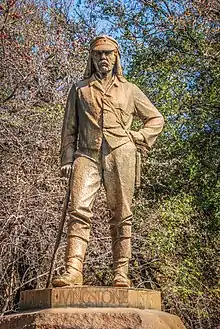 |
David Livingstone | Victoria Falls, Zambia | 1934 | Statue | [4] | ||||
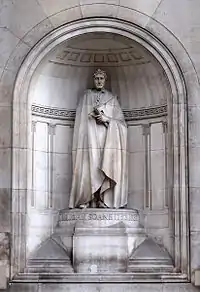 |
John Soane | Lothbury facade, Bank of England, City of London | 1930–1937 | Statue in alcove | Portland stone | Q30410805 | Architect, Herbert Baker.[26] | ||
 |
Boy with Goose | 27 Poultry, City of London | 1936–1937 | Two sculptures | Stone | Grade I | Architect, Edwin Lutyens.[27] | ||
.jpg.webp) |
Untitled | Adelaide House, King William Street, London | 1936-37 | Statue with globe | Granite and bronze | [28] | |||
 |
The Herald | 85 Fleet Street, London | 1938–1939 | Sculpture | Bronze | 1.9m high | Grade II | Architect, Edwin Lutyens.[29][30] | |
 More images |
George V | Howard Davis Park, Jersey | 1939 | Statue on pedestal | Bronze and granite | Q99528341 | Completed by Dick following death of sculptor Francis William Doyle Jones in June 1938.[31] |
1940 and later
| Image | Title / subject | Location and coordinates |
Date | Type | Material | Dimensions | Designation | Wikidata | Notes |
|---|---|---|---|---|---|---|---|---|---|
 More images |
Statue of George V | Old Palace Yard, London | 1947 | Statue on pedestal | Portland stone | 3m tall | Grade II | Q7604483 | Architect, Giles Gilbert Scott.[32] |
 More images |
Franklin Delano Roosevelt | Grosvenor Square, London | 1948 | Statue on pedestal | Bronze and stone | Grade II | Q25339025 | [33] | |
| Horlicks Limited War Memorial | Stoke Poges Lane, Slough | 1949 | Sculpture on pedestal | Bronze and limestone | Grade II | Q66479528 | [34][35] | ||
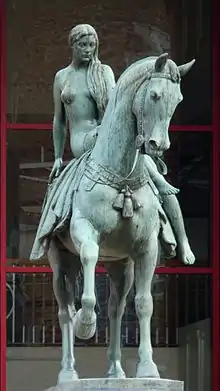 More images |
Lady Godiva | Broadgate, Coventry | 1949 | Statue on pedestal | Bronze and Portland stone | Grade II* | Q17540305 | [36] | |
 More images |
Queen Mary | Marlborough Road, The Mall, London | 1967 | Plaque | Q27950126 |
Other works
- Bas-reliefs for Selfridges store in Oxford Street, London, 1928.[37][4]
- Figures for St Andrew's House in Edinburgh, 1939.[4]
- The Tate Gallery has a bronze mask of a man entitled Androdus by Reid Dick, and the National Portrait Gallery has a Reid Dick bust of Lord Duveen.
- Harry Dwight Ripley Monument. St. Marylebone Cemetery and Crematorium.[38]
- Bronze bust of Winston Churchill, 1943.[4]
- Statue entitled Welcome, in Nottingham Council House
References
- University of Glasgow History of Art / HATII (2011). "Sir William Reid Dick RA, HRSA, KCVO". Mapping the Practice and Profession of Sculpture in Britain & Ireland 1851–1951. Retrieved 14 November 2020.
- Gary Nisbet. "Sir William Reid Dick (1879-1961)". Glasgow - City of Sculpture. Retrieved 14 November 2020.
- "Dick, Sir William Reid (1879–1961) Knight Sculptor". The National Archives. 19 June 2013. Retrieved 14 November 2020.
- "Dick, Sir William Reid". The Glasgow School of Art Archives and Collections. Retrieved 15 November 2020.
- "Reid Dick's Service Record WO 363/MIS-SORTS 34/52", "Burnt Records" series, National Archives, UK
- Patricia R. Andrew (2014). Chism In Time Scottish War Art and Artists in the Twentieth Century. Birlinn Ltd. ISBN 978 1 78027 190 3.
- Frances Spalding (1990). 20th Century Painters and Sculptors. Antique Collectors' Club. ISBN 1 85149 106 6.
- "William Reid Dick". Olympedia. Retrieved 29 July 2020.
- David Buckman (2006). Artists in Britain Since 1945 Vol 1, A to L. Art Dictionaries Ltd. ISBN 0 953260 95 X.
- "War Memorials Register: Angus Watson and Co Ltd". Imperial War Museum. Retrieved 14 November 2020.
- "War Memorials Register: Rickmansworth Cenotaph". Imperial War Museum. Retrieved 14 November 2020.
- Historic England. "War Memorial about 40m East of Church of St Mary (1296164)". National Heritage List for England. Retrieved 14 November 2020.
- "War Memorials Register: Rickmansworth". Imperial War Museum. Retrieved 14 November 2020.
- Historic England. "War Memorial statue (1348251)". National Heritage List for England. Retrieved 14 November 2020.
- "War Memorials Register: Bushey". Imperial War Museum. Retrieved 14 November 2020.
- Historic England. "The War Memorial at junction with School Lane (1103581)". National Heritage List for England. Retrieved 14 November 2020.
- "War Memorials Register: Royal Air Force". Imperial War Museum. Retrieved 14 November 2020.
- Historic England. "The Royal Air Force Memorial, Whitehall Stairs (1066171)". National Heritage List for England. Retrieved 14 November 2020.
- "The Chapels". St Paul's Cathedral. Retrieved 15 November 2020.
- "War Memorials Register: Field Marshal Earl Kitchener". Imperial War Museum. Retrieved 15 November 2020.
- "Pietà and Dancing Putti". Victoria & Albert Museum. Retrieved 15 November 2020.
- "The Menin Gate Memorial". Commonwealth Graves Commission. Retrieved 21 November 2012.
- Historic England. "Leverhulme Memorial at junction with Queen Mary's Drive (1075393)". National Heritage List for England. Retrieved 14 November 2020.
- "Sketch for Leverhulme Memorial (Port Sunlight) c. 1930". Tate. Retrieved 15 November 2020.
- "The Arras Memorial". Commonwealth Graves Commission. Retrieved 21 November 2012.
- Statue of Sir John Soane Victorian Web. Retrieved 21 November 2012
- Historic England. "Midland Bank (1064598)". National Heritage List for England. Retrieved 16 November 2020.
- "Adelaide House". Victorian Web. Retrieved 21 November 2012.
- Historic England. "9, Salisbury Court EC4, 82-85, Fleet Street, EC4 (1064656)". National Heritage List for England. Retrieved 14 November 2020.
- "Herald". Victorian Web. Retrieved 15 November 2020.
- University of Glasgow History of Art / HATII (2011). "Francis William Doyle Jones". Mapping the Practice and Profession of Sculpture in Britain & Ireland 1851–1951. Retrieved 15 November 2020.
- Historic England. "Statue of George V (1225528)". National Heritage List for England. Retrieved 14 November 2020.
- Historic England. "Statue of President Roosevelt in centre of Square Gardens (1066737)". National Heritage List for England. Retrieved 14 November 2020.
- "War Memorials Register: Horlicks Limited war memorial". Imperial War Museum. Retrieved 14 November 2020.
- Historic England. "Horlicks War Memorial, Slough (1454798)". National Heritage List for England. Retrieved 16 November 2020.
- Historic England. "Lady Godiva statue (1031589)". National Heritage List for England. Retrieved 14 November 2020.
- Selfridges Victorian Web. Retrieved 21 November 2012
- Harry Dwight Ripley Monument Victorian Web. Retrieved 21 November 2012
Further reading
- Wardleworth, Dennis (2013). William Reid Dick, Sculptor. Farnham: Ashgate. ISBN 978-1-4094-3971-4.
External links
![]() Media related to William Reid Dick at Wikimedia Commons
Media related to William Reid Dick at Wikimedia Commons